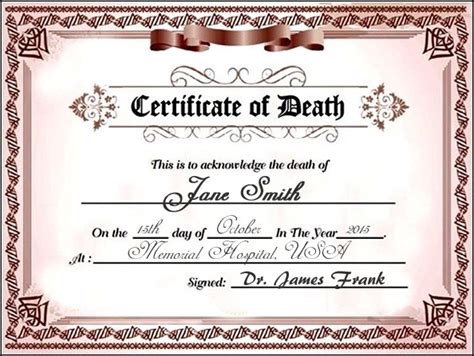How To Obtain a Death Certificate: A Comprehensive Guide
Obtaining a death certificate might seem daunting, but understanding the process simplifies things considerably. This guide walks you through the necessary steps, regardless of your location or circumstances. We'll cover everything from identifying the responsible agency to understanding the required documentation and potential fees.
Understanding the Process: Where to Start?
The first and most crucial step is identifying the responsible vital records office. This office varies depending on where the death occurred:
- Within the United States: The responsible agency is typically the state or county vital records office where the death occurred. Each state has its own process and procedures. A simple online search for "[State Name] vital records" will usually direct you to the correct website.
- Outside the United States: The process differs significantly by country. You will need to contact the relevant authorities in the country where the death occurred. Embassies or consulates may also offer assistance.
Required Documentation and Information:
To successfully obtain a death certificate, you'll typically need to provide specific information. This often includes:
- Deceased's Full Name: Ensure accuracy, including any middle names or initials.
- Date of Death: This is crucial for locating the record.
- Place of Death (City and State/Country): Precise location is vital.
- Social Security Number (SSN): This is usually required, but policies vary by state.
- Your Relationship to the Deceased: You'll need to establish your eligibility to request the certificate. This could include being a spouse, child, parent, or legal representative.
- Your Identification: You might need to provide your own identification, such as a driver's license or passport.
Special Circumstances:
- If the death occurred recently: The death certificate may not yet be available. Allow sufficient processing time (often several weeks).
- If the death occurred many years ago: The process may require additional steps and more documentation.
- If you need certified copies: Indicate this clearly when making your request, as certified copies typically carry an extra fee and are necessary for legal matters like insurance claims or estate settlement.
Methods of Obtaining a Death Certificate:
Several methods exist for obtaining a death certificate:
- Online Application: Many states offer online application portals, often streamlining the process and providing quicker turnaround times.
- Mail-in Application: You can download and complete an application form (available on the relevant vital records website) and mail it along with the required fee and supporting documentation.
- In-Person Application: Visiting the vital records office in person allows for immediate processing, but this option requires travel and may have longer wait times.
Fees and Processing Times:
Expect to pay a fee for each death certificate requested. Fees vary significantly by state and the type of certificate (certified vs. uncertified). Processing times also vary, from a few days to several weeks, depending on the method of application and the office's workload.
Tips for a Smooth Process:
- Allow Ample Time: Start the process well in advance of when you need the certificate.
- Keep Records: Maintain copies of your application, supporting documents, and correspondence.
- Be Patient: Processing times can vary, so patience is key.
- Contact the Office Directly: If you have questions or encounter difficulties, contact the relevant vital records office directly for assistance.
Obtaining a death certificate is a necessary step in many situations. By following this guide and understanding the specific requirements of your jurisdiction, you can navigate the process efficiently and successfully. Remember to always check the specific requirements of your state or country's vital records office for the most accurate and up-to-date information.
